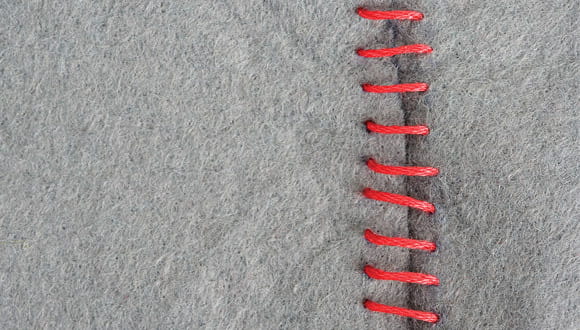How Long Do Stitches Stay In? (& More Questions About Caring for Stitches, Answered)
Nov. 4, 2022 - Katie McCallumIt's not every day you need stitches, so knowing how to care for them isn't exactly common knowledge.
Not to worry.
Dr. Michael Yaakovian, a surgeon and wound-care specialist at Houston Methodist, answers eight common questions about stitches.
Can you get stitches wet?
"In the first 48 hours, the goal is to keep your stitches completely dry," says Dr. Yaakovian. "It takes about a day or two for skin to form a new layer and, for this to happen effectively, it's best if the skin is dry."
And — just to be clear — yes, this means waiting two days before you shower.
After those first 48 hours, though, it's totally fine to get your stitches briefly wet via the light spray of a shower. But emphasis on "briefly" here. Dr. Yaakovian stresses that you'll want to avoid soaking or submerging your stitches in water for about four weeks. That is, avoid taking a bath or getting in a pool or hot tub during this time.
"In order to help prevent infection, we want stitches to stay as dry as possible until they're removed and the area is completely healed," explains Dr. Yaakovian.
That's because a moist environment is essentially a breeding ground for infection-causing bacteria.
Should you keep stitches covered?
You'll likely leave the hospital or your provider's office with your stitches already covered, and Dr. Yaakovian recommends leaving them dressed for two to three days. During this time, avoid getting the covering wet.
Once you remove the dressing, you likely don't need to put anything else on your stitches — such as petroleum oil or antibiotic ointments. You also don't need to "clean" the suture site with hydrogen peroxide. In fact, this can cause more harm than good.
"You can leave your stitches as is at this point," says Dr. Yaakovian. "And if you choose to use a scar prevention cream, be sure to wait to do so until the area is completely closed."
If a tissue adhesive or glue was used instead of sutures, there's no need to cover the area.
Why are my stitches itchy?
"Itching is a natural part of the healing process," says Dr. Yaakovian. "The inflammatory cells that help fight infections also help heal a wound. Some of the healing chemicals these cells produce, such as histamine, cause itching."
He adds that itchiness may also be due to damaged and irritated nerve endings. It can also be a reaction to either the material of the suture or glue if tissue adhesive was used to close the site. Or it can be a reaction to the tape used to apply the dressing covering the stitches.
"In some cases, itching may be the result of a yeast infection, though this is a less common reason for it," says Dr. Yaakovian.
Can you exercise with stitches?
Depending on the location and size of your stitches, you may worry about whether exercise or physical activity might pull them apart and open the wound.
"It takes about four to six weeks for tissue to rebuild to its maximum strength, during which time it's best to avoid tension, stretching or shearing forces at the suture site," explains Dr. Yaakovian.
During this time, depending on where the stitches are, you may need to consider rethinking what type of workouts you're doing, how you use certain limbs. Your doctor can give you specific advice regarding the motions and activities you should avoid until your stitches are out and the area has healed.
How can you tell if stitches are infected?
As with any wound that's healing, you'll want to watch out for signs of infection, which include:
- Redness
- Itching
- Tenderness or pain
- Drainage
- Fever and chills
"A little redness around the suture line is normal, but if the redness increases and is accompanied by other signs of infection, consult your doctor," recommends Dr. Yaakovian. "If there is an infection, the stitches may need to be removed and the site drained and cleaned."
How long do stitches stay in?
The length of time stitches remain in your skin varies based on the type of stitches used and where on the body they're located.
"Dissolvable stitches placed internally won't need to be removed," says Dr. Yaakovian. "They will break down and disappear on their own over time. As for permanent stitches placed on the outside of the skin, these are typically left in for about two weeks before being removed."
This timeline shortens in some cases, such as to prevent scarring for stitches placed on the face. It can also lengthen for stitches located in more vulnerable areas of the body.
Your doctor will inform you ahead of time how long your stitches should stay in.
Can stitches be left in too long?
It's important to be sure you understand when your stitches need to be removed and schedule a follow-up appointment that aligns with the recommended time frame.
"Stitches can be left in too long," warns Dr. Yaakovian. "When this happens, the skin can grow over the stitches — making removal more difficult. It can also lead to more scarring."
How are stitches removed?
"Suture removal is typically straightforward — the stitches are simply cut and then pulled out," says Dr. Yaakovian. "You may feel some pressure and tugging, but it shouldn't be painful, and no anesthetic is needed for this."
Though it sounds simple, this isn't something you should try to do yourself at home and without your doctor's approval.
"In some cases, dissolvable stitches placed inside the body may poke out of the skin, but it's important to leave them alone," adds Dr. Yaakovian. "If you're worried, contact your doctor to find out how long your dissolvable stitches are meant to remain intact and whether you should come in to have any that protrude snipped."


